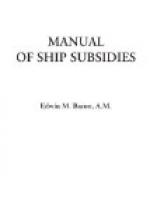The next year, 1846, in the annual post-office appropriations act (June 19), provision was made for the application of twenty-five thousand dollars toward the establishment of a line of mail steamers between the United States and Bremen; and early in 1847 (February 3) a contract was duly concluded for a Bremen and Havre service, the first under the law of 1845.
This was a five years’ contract entered into with the Ocean Steam Navigation Company, upon the basis of an earlier agreement (February 1846) with Edward Mills of New York, which Mr. Mills had transferred to the new organization. The subsidy was fixed at one hundred thousand dollars a year for each ship going by Cowes to Bremen and back to New York once in two months a year, and seventy-five thousand dollars a year for each ship going by Cowes to Havre and back to New York. The contractors were to build within a year’s time four first-class steamships of not less than 1400 tons, nor less than a thousand horsepower; and were to run their line “with greater speed to the distance than is performed by the Cunard Line between Boston and Liverpool and back."[FW] Provision for the subsidy thus called for was promptly made in this item in the post-office appropriation bill for the ensuing year, approved March 2: “for transportation by steam-ships between New York and Bremen according to the contract with Edward Mills, $258,609."[FX]
The next step was the enactment of a law which had for its declared objects “to provide efficient mail services, to encourage navigation and commerce, and to build up a powerful fleet in case of war."[FY] This measure, approved March 3, 1847, entitled “An act to provide for the building and equipment of four naval steamships,” made provision for the construction, with Government aid, of merchant mail-steamships under the supervision of the Navy Department that they might be rendered suitable if needed for war service.




